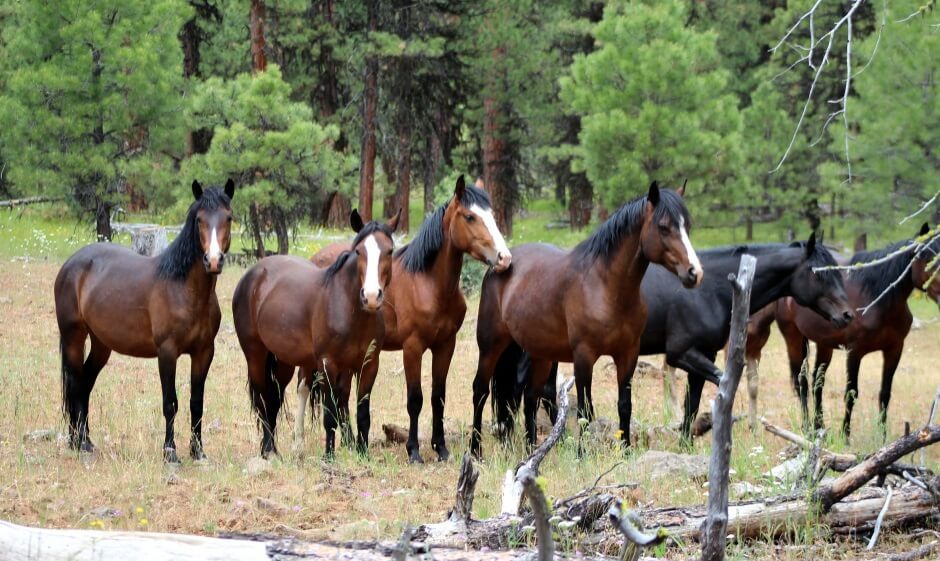The U.S. Forest Service lawfully amended a management plan to remove nearly two-thirds of wild horses in the Ochoco National Forest.
by ALANNA MAYHAM – Published on Courthouse News
PORTLAND, Ore. (CN) — A federal judge delivered a blow to wild horse conservationists on Monday evening by ending efforts to prevent the removal of roughly 88 wild horses from the Ochoco National Forest in eastern Oregon.
The order by U.S. District Judge Michael H. Simon adopted the findings and recommendations of Magistrate Judge Andrew D. Hallman in May. Hallman found and Simon agreed the U.S. Forest Service did not violate the National Environmental Policy Act or the Wild Free-Roaming Horses and Burros Act by approving an updated management plan for the Big Summit Wild Horse Territory that would reduce its wild horse population from 135 horses to less than half.
The wild horses at issue reside about 25 miles east of Prineville, Oregon, within the Ochoco National Forest and represent the only wild horse population in the Pacific Northwest, according to the Forest Service. The agency manages the herd on territory established in 1975 through the Wild Free-Roaming Horses and Burros Act of 1971, which directs the Forest Service to protect and manage wild horses in a manner consistent with maintaining natural ecological balance.
To manage the wild horses, however, the Forest Service must set an appropriate management level for the herd, requiring the agency to remove excess horses when the herd becomes too large.
In May 2021, the Forest Service announced its amendments to the Ochoco Land and Resource Management Plan, establishing a new territory capacity of 47 to 57 wild horses from its 1989 adjustment of 55 to 60. The agency stated its amendments would allow for necessary adjustments depending on territory conditions and enable it to collaborate with experts to monitor and improve the herd’s genetic variability.
But not everyone agreed the Forest Service’s amendments aligned with the herd’s best interests, especially since the herd reached 135 horses in 2018.
Within six months, Prineville residents Gayle Hunt and Melinda Kestler joined the Central Oregon Wild Horse Coalition in suing three Forest Service officials and U.S. Department of Agriculture Secretary Tom Vilsack, claiming that the Forest Service’s new plan will cause the herd’s extinction through drastic reductions and an irretrievable loss of genetic variability.
In January 2023, Judge Hallman conducted a lengthy hearing on motions for summary judgment from both sides. Government attorney Christian Carrara argued the overpopulated herd has a greater effect on the riparian environment than cattle or sheep, and leaves insufficient forage even for the horses. Another government attorney, Hannah O’Keefe, told Hallman the horses that could not be sold or adopted privately would be euthanized.
Plaintiff attorney Bruce Wagman disagreed with the government’s research around the riparian environment, stating the research was based on two years’ worth of data taken from harsh winters. But despite this claim of “cherry-picking” data, Hallman ultimately sided with the Forest Service in finding that the agency’s data sets did not violate the National Environmental Policy Act.
“It was reasonable for the service to only analyze reliable data from high snowfall years, given its conclusion that high snowfall years were the most limiting factor,” Hallman wrote. “Thus, the service did not violate NEPA’s hard look requirement by relying on its experts to determine that high snowfall years were the most limiting factor and then utilizing official data from the two most recent high snowfall years.”
Hallman also found the Forest Service provided sufficient reasoning and support for its analysis of the herd’s winter range and refusal of the plaintiffs’ contradicting data, which aided the agency’s defense against the claim that its range determination ignored evidence that horses have survived in larger numbers than its capacity range prescribes.
Among other disagreements, including that the government’s reduction would decimate the herd with a lack of genetic variability, Hallman ultimately found the Forest Service made proper adjustments to its management plan with supported analysis and under its legal requirements. Judge Simon adopted Hallman’s reasonings in full, finding the plaintiffs failed to show error by the magistrate judge “other than that plaintiffs disagree with the outcome.”
Neither the Central Oregon Wild Horse Coalition nor the Forest Service immediately responded to a request for comment or an interview.

News from the horse industry. Sharing today’s information as it happens. The Northwest Horse Source is not responsible for the content of 3rd party submissions.






